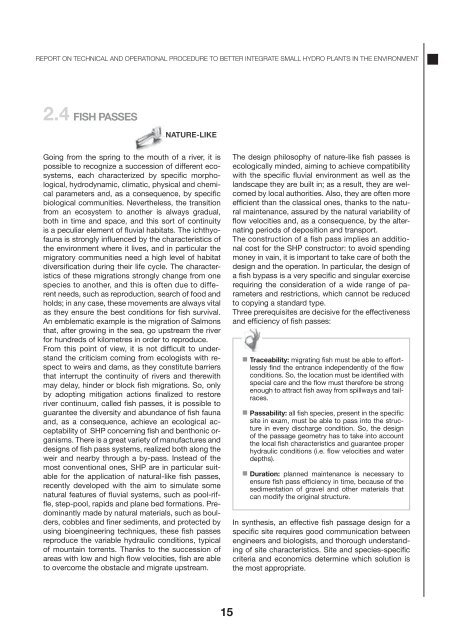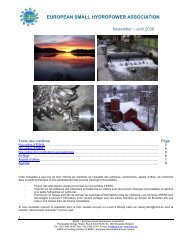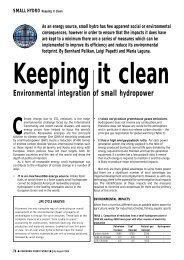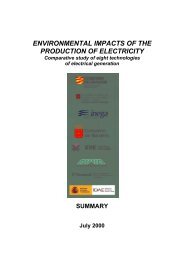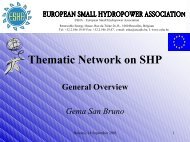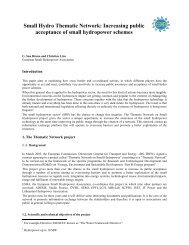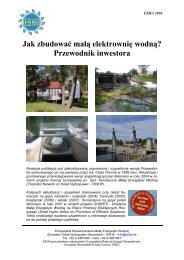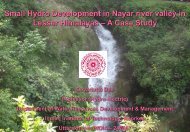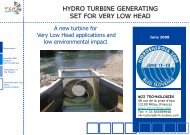HYDROPOWER AND ENVIRONMENT - ESHA
HYDROPOWER AND ENVIRONMENT - ESHA
HYDROPOWER AND ENVIRONMENT - ESHA
You also want an ePaper? Increase the reach of your titles
YUMPU automatically turns print PDFs into web optimized ePapers that Google loves.
REPORT ON TECHNICAL <strong>AND</strong> OPERATIONAL PROCEDURE TO BETTER INTEGRATE SMALL HYDRO PLANTS IN THE <strong>ENVIRONMENT</strong><br />
2.4<br />
FISH PASSES<br />
NATURE-LIKE<br />
Going from the spring to the mouth of a river, it is<br />
possible to recognize a succession of different ecosystems,<br />
each characterized by specifi c morphological,<br />
hydrodynamic, climatic, physical and chemical<br />
parameters and, as a consequence, by specifi c<br />
biological communities. Nevertheless, the transition<br />
from an ecosystem to another is always gradual,<br />
both in time and space, and this sort of continuity<br />
is a peculiar element of fl uvial habitats. The ichthyofauna<br />
is strongly infl uenced by the characteristics of<br />
the environment where it lives, and in particular the<br />
migratory communities need a high level of habitat<br />
diversifi cation during their life cycle. The characteristics<br />
of these migrations strongly change from one<br />
species to another, and this is often due to different<br />
needs, such as reproduction, search of food and<br />
holds; in any case, these movements are always vital<br />
as they ensure the best conditions for fi sh survival.<br />
An emblematic example is the migration of Salmons<br />
that, after growing in the sea, go upstream the river<br />
for hundreds of kilometres in order to reproduce.<br />
From this point of view, it is not diffi cult to understand<br />
the criticism coming from ecologists with respect<br />
to weirs and dams, as they constitute barriers<br />
that interrupt the continuity of rivers and therewith<br />
may delay, hinder or block fi sh migrations. So, only<br />
by adopting mitigation actions fi nalized to restore<br />
river continuum, called fi sh passes, it is possible to<br />
guarantee the diversity and abundance of fi sh fauna<br />
and, as a consequence, achieve an ecological acceptability<br />
of SHP concerning fi sh and benthonic organisms.<br />
There is a great variety of manufactures and<br />
designs of fi sh pass systems, realized both along the<br />
weir and nearby through a by-pass. Instead of the<br />
most conventional ones, SHP are in particular suitable<br />
for the application of natural-like fi sh passes,<br />
recently developed with the aim to simulate some<br />
natural features of fl uvial systems, such as pool-riffl<br />
e, step-pool, rapids and plane bed formations. Predominantly<br />
made by natural materials, such as boulders,<br />
cobbles and fi ner sediments, and protected by<br />
using bioengineering techniques, these fi sh passes<br />
reproduce the variable hydraulic conditions, typical<br />
of mountain torrents. Thanks to the succession of<br />
areas with low and high fl ow velocities, fi sh are able<br />
to overcome the obstacle and migrate upstream.<br />
15<br />
The design philosophy of nature-like fi sh passes is<br />
ecologically minded, aiming to achieve compatibility<br />
with the specifi c fl uvial environment as well as the<br />
landscape they are built in; as a result, they are welcomed<br />
by local authorities. Also, they are often more<br />
effi cient than the classical ones, thanks to the natural<br />
maintenance, assured by the natural variability of<br />
fl ow velocities and, as a consequence, by the alternating<br />
periods of deposition and transport.<br />
The construction of a fi sh pass implies an additional<br />
cost for the SHP constructor: to avoid spending<br />
money in vain, it is important to take care of both the<br />
design and the operation. In particular, the design of<br />
a fi sh bypass is a very specifi c and singular exercise<br />
requiring the consideration of a wide range of parameters<br />
and restrictions, which cannot be reduced<br />
to copying a standard type.<br />
Three prerequisites are decisive for the effectiveness<br />
and effi ciency of fi sh passes:<br />
Traceability: migrating fi sh must be able to effortlessly<br />
fi nd the entrance independently of the fl ow<br />
conditions. So, the location must be identifi ed with<br />
special care and the fl ow must therefore be strong<br />
enough to attract fi sh away from spillways and tailraces.<br />
Passability: all fi sh species, present in the specifi c<br />
site in exam, must be able to pass into the structure<br />
in every discharge condition. So, the design<br />
of the passage geometry has to take into account<br />
the local fi sh characteristics and guarantee proper<br />
hydraulic conditions (i.e. fl ow velocities and water<br />
depths).<br />
Duration: planned maintenance is necessary to<br />
ensure fi sh pass effi ciency in time, because of the<br />
sedimentation of gravel and other materials that<br />
can modify the original structure.<br />
In synthesis, an effective fi sh passage design for a<br />
specifi c site requires good communication between<br />
engineers and biologists, and thorough understanding<br />
of site characteristics. Site and species-specifi c<br />
criteria and economics determine which solution is<br />
the most appropriate.


